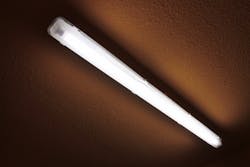Emergency lighting is critically important to enable people to safely exit buildings during an emergency or any power outage. So you would think it was a great development that multiple manufacturers have released emergency LED tubes (also known as TLEDs) that convert an ordinary fluorescent linear fixture into an emergency TLED fixture, right? If one is only looking at convenience, perhaps, but the devil is in the details. All of the emergency TLEDs on the market today are missing a critical safety listing.
UL 924
UL 924 is the UL safety standard for emergency lighting and power equipment. Emergency battery backups for lighting systems have long been safety listed to the UL 924 standard, in order to demonstrate electrical and functional safety, as well as satisfy the National Electrical Code (NEC). This was true of emergency battery backups for fluorescent fixtures, and UL 924 remains the standard for the newer emergency inverters for LED fixtures as well as fixtures converted to Type B TLEDs. UL 924 contains a variety of requirements for emergency lighting, including 90+ minutes of emergency operation, as one well-known example. Another requirement is permanent mounting except for cord-connected auxiliary lighting, as shown below.
The G13 TLEDs with tombstones are clearly not permanent mounting nor cord-connected, as they are tool-less replaceable lamps. Therefore, emergency TLEDs cannot meet UL 924, and in fact, none of the models on the market today have been UL 924 listed.
Don’t be fooled
Perhaps you’ve seen the UL or ETL mark on the spec sheets and think that should be the end of the issue. Not so fast. Emergency TLEDs on the market today have been safety listed as Type B TLEDs only (UL 1598C), not as emergency lighting (UL 924). To confirm this, you can go to the respective safety listing agency’s website and look up the emergency TLED model (https://www.ul.com/ and https://www.intertek.com/marks/etl/). It will show UL 1598C approval only, and not UL 924. Some manufacturers have stated this in the fine print on their spec sheets, while others have not.
Consider the scenario where a facility manager believes that they have adequate emergency lighting utilizing emergency TLEDs. Over time, emergency TLEDs will eventually fail. With personnel changes or by accident, emergency TLEDs may be replaced with standard TLEDs. Some emergency lighting in the building is now removed, creating potentially life-threatening conditions during an emergency or even a simple power outage.
Additional issues with emergency TLEDs
Lack of UL 924 listing is the most serious issue with emergency TLEDs, but not the only problem:
- Emergency TLEDs can require unshunted sockets, often meaning a socket change.
- Different wiring for emergency TLEDs and regular TLEDs in the same fixture can easily lead to problems, both during wiring and during relamping. A fixture can now contain wiring for single-ended TLEDs or double-ended TLEDs, and emergency TLEDs. Errors can lead to short circuits and malfunctions.
- When emergency TLEDs are in a fixture with standard TLEDs, the fixture appearance will often be altered when illuminated, due to the longer end-caps that are typical on emergency TLEDs.
What should we do?
The best solution for providing emergency functionality to fixtures with Type B TLEDs is a hardwired emergency inverter that is UL 924 listed. This also eliminates the socket changes, wiring changes, and compromised fixture appearance issues, listed above. Consider emergency inverters having form factors that fit within the fixture’s ballast channel, to maintain illuminated fixture appearance. An emergency inverter enables all of the lamps within the fixture to remain the same, which is easier for lamp replacements, while meeting all emergency lighting requirements. The risk of putting a basic TLED on a socket wired for emergency TLEDs is eliminated.
Get to know our expert
For up-to-the-minute LED and SSL updates, why not follow us on Twitter? You’ll find curated content and commentary, as well as information on industry events, webcasts, and surveys on our LinkedIn Company Page and our Facebook page.








